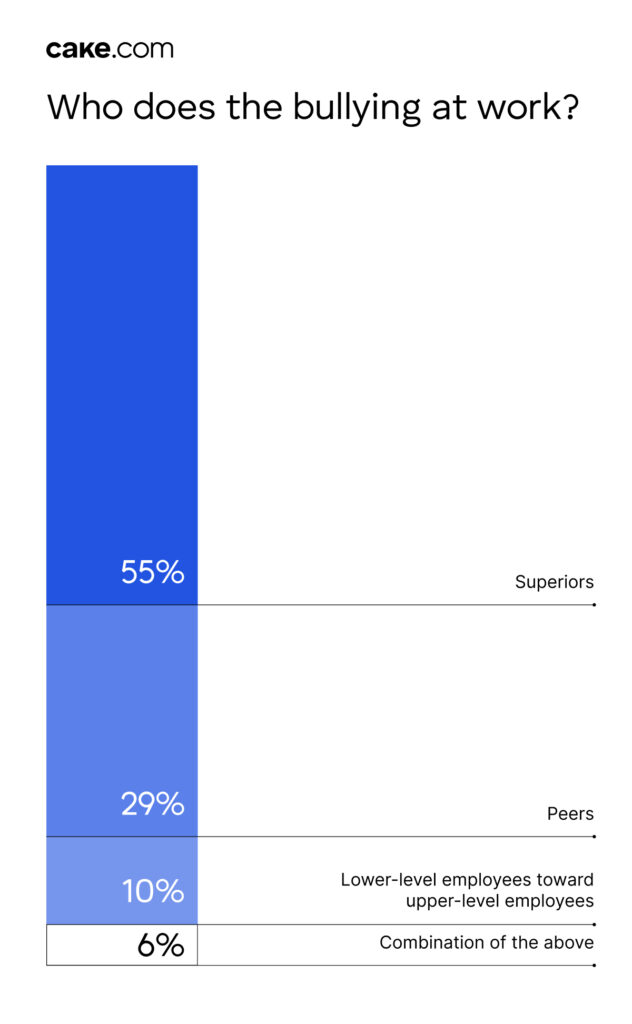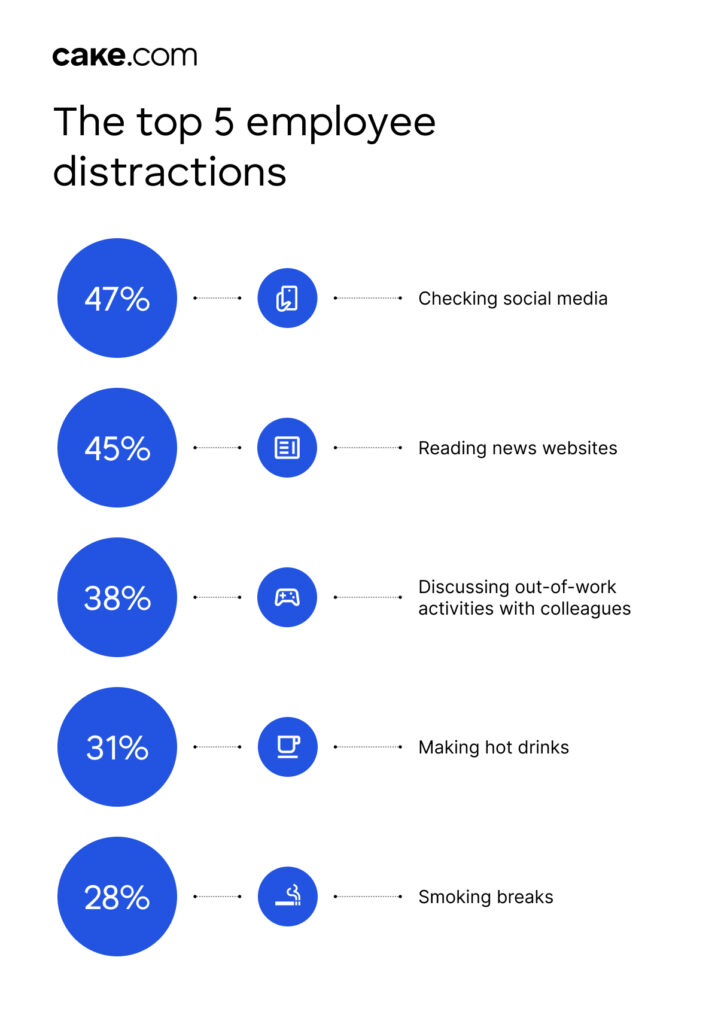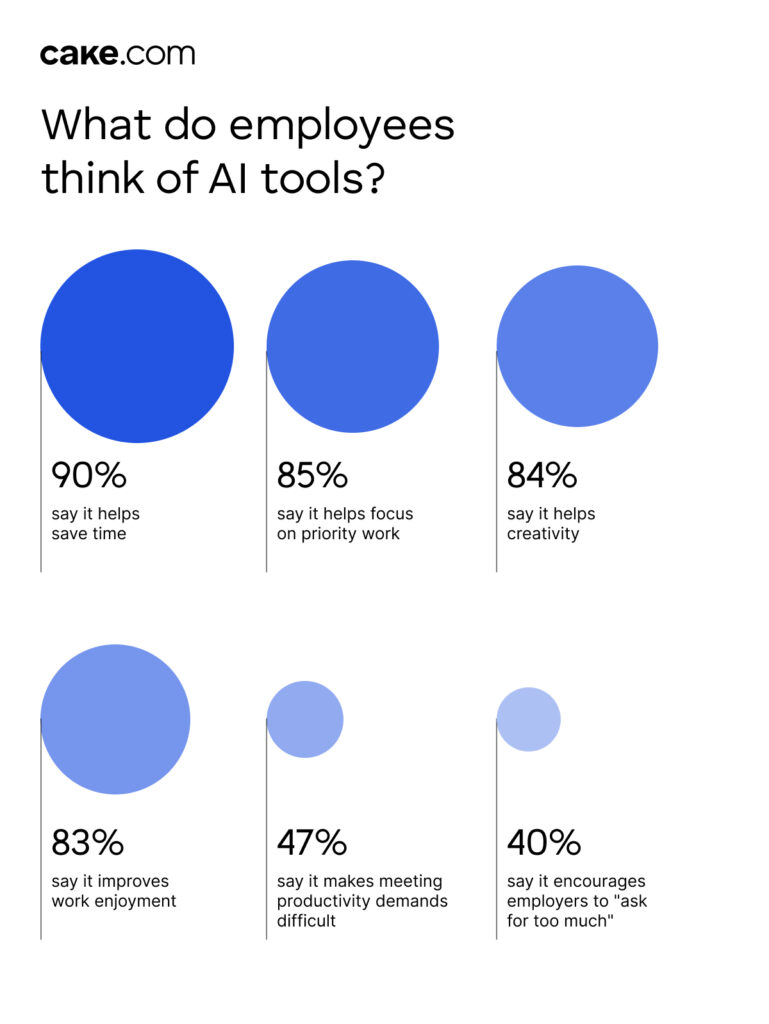Only 10 years ago, nobody would have thought that so many employees (32%) would be quietly quitting, or that a staggering 90% of US employees would report having at least one mental health challenge.
Yet, this is a logical consequence of job insecurity, workplace harassment, and new technologies.
Creating a safe space where employees feel engaged and happy, however, brings many rewards, the most important ones being productivity and profit rise.
Feel the pulse of the current state of the workplace so that you can make the right decisions when it comes to your company, as we bring you the latest workplace statistics based on reliable sources.
Key workplace statistics
Before we delve into the detailed statistics and explanations about the current state of the workplace, here’s a little preview:
- 27% of the global workforce believes they’re not paid fairly.
- 50% of employees are actively looking for a new job.
- 90% of US workers report having at least one mental health challenge.
- 21% of employees globally are engaged at work.
- 52.2 million US workers are directly bullied at work.
- 65% of workers want more schedule flexibility, the so-called — microshifting.
- 32% of employees engage in quiet quitting.
- 72% of business leaders wish they had more effective communication tools.

Employee workplace (dis)satisfaction
Let’s see the most common causes of employee workplace satisfaction, or more precisely, dissatisfaction.
36% of workers report heavier workloads due to unfilled roles
According to the 2025 SHRM State of the Workplace report, only slightly more than half (56%) of HR professionals consider their organization’s recruiting efforts to be effective or very effective. This number is significantly lower among employees, as only 41% share this belief.
Ineffective recruitment efforts lead to unfilled roles, and 36% of workers reported heavier workloads due to unfilled positions in 2024.
As a consequence, employees who report increased workloads due to staff shortages tend to report feelings of burnout as well (61%). For comparison, only 18% of employees who report feelings of burnout didn’t also report workload pressure.
34% of US workers report a lack of recognition for their contributions
The previously mentioned 2025 SHRM report notes that 34% of US workers reported a lack of recognition for their contributions. The reason for 25% of them was insufficient collaboration or support within their teams. For another 15%, the reason was unfair performance evaluations.
27% of the global workforce believes they’re not paid fairly
The ADP’s People at Work 2025 research interviewed 38,000 workers globally about how they felt about the fairness of their pay. 27% reported that their pay wasn’t fair.
Out of these 27%, women were more likely to report unfair pay (28%) compared to men (23%).
Additionally, the higher the employees’ roles were, the less likely they were to believe they weren’t fairly paid. For example, only 13% of the C-Suite and 15% of upper management employees stated unfair pay, as compared to 34% of the lower-level employees.
50% of employees are watching out for or actively seeking a new job
Gallup’s 2025 State of the Global Workplace research found that as many as 50% of employees are looking for opportunities or actively seeking a new job. And, according to the Owl Labs’ 2025 State of Hybrid Work report, the top reasons for searching for a new role are:
- Better pay — 49%,
- Improved work-life balance — 48%, and
- Stronger career growth opportunities — 44%.
However, perhaps we’re not looking broadly enough when it comes to the employee workplace satisfaction topic.
Pew Research Center’s 2024 research on job satisfaction has come to an interesting conclusion. Namely, self-employed employees were more satisfied with their job (60%), compared to only 49% who weren’t self-employed.
Mental health in the workplace statistics
Workplace stress affects mental health, and more and more employees report having mental health challenges. Here are the specifics.
47% of employees admit that work stress is taking a toll on their mental health
Employee well-being is coming into the spotlight as more and more employees feel the consequences of work-related stress.
Here are the key statistics about employees’ opinions on well-being, according to Wellhub’s 2025 The State of Work-Life Wellness report:
- 47% of employees admit that work stress is taking a toll on their mental health.
- 83% of employees would consider leaving the company that does not focus on employee well-being.
- 85% of employees believe their employer has a responsibility to help them tend to their well-being.
- 88% of employees value their well-being at work just as much as their salary.

Employee well-being statistics
90% of US workers report at least minor levels of one mental health challenge
In 2025, 90% of US workers said they have at least one mental health challenge, which is the highest percentage recorded since 2019, according to the 2025 Mental Health at Work Report by Mind Share Partners.
Half (50%) of US workers report moderate to severe levels of burnout, depression, or anxiety. And nearly half (48%) have left jobs for mental health reasons. Out of these 48%, 67% of leaves were voluntary.
13% of employees told their superiors their mental health was suffering due to work
According to the Ipsos-NAMI’s 2025 Workplace Mental Health Survey, only 13% of employees claim they told their managers or supervisors that their mental health was suffering due to the work demands.
The reason for this may lie in the fact that 42% of employees worry their career would be negatively impacted if they talked about mental health concerns in the workplace.
At the same time, 67% of executives or managers haven’t even received training about how to talk about mental health with their team at work.
These findings indicate there is plenty more work to be done when it comes to handling employees’ mental health.
32% of employees report that they’re constantly watched by their employer
According to the already mentioned ADP Research Global Workforce Survey, 32% of employees feel they’re constantly being watched by their employers.
The same research shows that workers who say they’re watched on the job are 3 times more likely to experience stress, and consequently are less productive.
However, the issue doesn’t necessarily lie in the monitoring process itself — but rather in communication. The research concludes that transparent, open, and frequent communication about the demands can resolve this issue and put the workers at ease.
Employee engagement at work
An engaged employee is like a holy grail for productivity and, consequently, the company’s profit. However, at least for the time being, it appears that we’re far from finding a truly engaged employee.
$438 billion was lost last year due to lower employee engagement
Globally, currently only 21% of employees are engaged at work, according to the already mentioned Gallup’s 2025 State of the Global Workforce report. This has cost the global economy $438 billion in lost productivity.
Gallup estimates that if the workforce were fully engaged, the world economy would add $9.6 trillion in productivity annually.
70% of team engagement depends on the manager
The above-mentioned 2025 Gallup research indicates that a staggering 70% of team engagement depends on the manager.
Unfortunately, the biggest drop in employee engagement is seen precisely in managers, down from 30%, which was the case in Gallup’s 2024 State of the Global Workforce report, to a mere 27%.
Further reading:
While it may sound burdensome that managers are almost solely responsible for the team’s engagement, there are several creative ways in which they can improve morale:
45% of employees stay at their company for career advancement opportunities
Almost half of the employees (45%) would stay at the company due to career advancement opportunities.
Another 36% see professional training and skills development as one of the top positive factors when deciding whether or not to leave the company.
Finally, 34% share that flexibility in scheduling is among the reasons to stick with their current employer.
These reasons can always serve as guidelines for upper management when it comes to increasing retention rates at their companies.
The turnover rate for disengaged teams is 43% higher than in engaged teams
The more disengaged employees are, the higher the turnover rate becomes. The People Element’s 2024 Employee Engagement Report showed that the turnover rate is 43% higher in disengagement teams.
Harassment in the workplace statistics
Bullying, discrimination, and harassment — these all happen throughout US companies each day. Let’s see what the numbers say.
52.2 million US workers are directly bullied at work
As stated in the 2024 Workplace Bullying Institute survey, 52.2 million American workers were directly bullied. But they weren’t the only ones affected by the bullying.
The survey found that another 26 million were indirectly affected, as they were witnessing the incidents. These digits combined make for 74.8 million Americans affected by workplace bullying.
55% of bullying comes from superiors
The same Workplace Bullying Institute research investigated who does the bullying. And, apparently, it’s common that superiors are involved:
- 55% comes from superiors,
- 29% comes from peers,
- 10% comes from lower-level employees toward upper-level employees, and
- 6% is a combination of all those mentioned above.

Workplace bullying in the US
91% of the US workers admit they have experienced discrimination
Discrimination among US workers is so common that a worrying 91% of US employees admit they have experienced it, according to a recent Monster poll on workplace discrimination.
Another 77% claim to have witnessed acts of discrimination at work.
Although discrimination can be related to gender, physical appearance, accent, sexual orientation, etc., it seems that the most common cases of discrimination are related to age and race.
Precisely, 50% of surveyees have been discriminated against based on their age, whereas 40% said it was due to their race.
42% of employees didn’t report an incident of workplace harassment
As reported by the latest Workplace Harassment and Misconduct Insights, as many as 42% of employees who experienced some form of workplace harassment or misconduct did not report it.
It appears that the reason for such a low number may be tied to employees not being comfortable with publicly reporting these types of incidents. The percentage of those who reported workplace harassment rose to 72% when they were allowed to report anonymously.
32% of women who reported workplace harassment were not satisfied with the outcome
According to the Traliant 2025 State of Workplace Harassment Report, a significant number of employees are not satisfied with how the employer handled the report.
Precisely, 32% of women were either not very, or not at all satisfied with the outcome. This percentage, however, is significantly lower with men, where only 20% of them were not satisfied with the harassment report outcome.
We can conclude that there’s plenty of room for improvement in how harassment reports are managed in the workplace.
Workplace productivity statistics
A healthy lifestyle and happiness go a long way in potentially increasing employee productivity. But remote/hybrid positions have a big role in this, as well. Check it out.
Eating healthy increases productivity by 34%
A study found the correlation between eating healthy and staying productive. The results showed that those workers who ate healthy showed higher productivity levels by as much as 34%.
69% of managers believe that hybrid/remote work has made their team more productive
The previously mentioned Owl Labs’ Survey found that 69% of managers believe that their team is more productive due to hybrid and remote work options.
Further reading:
Are you thinking about offering hybrid and remote work options to your employees? Inform yourself about the right models in the following blog post:
The average worker spends only 2 hours and 53 minutes working productively
The average worker spends only 2 hours and 53 minutes working productively, according to Voucher Cloud 2025 research. The top 5 distractions for workers are:
- Checking social media — 47%,
- Reading news websites — 45%,
- Discussing out-of-work activities with colleagues — 38%,
- Making hot drinks — 31%, and
- Smoking breaks — 28%.

Top 5 workplace distractions
The reason behind such low productivity can certainly be attributed to these main distractions, but that may be superficial. The root of low productivity may lie in outdated 9-to-5 shifts.
For example, the aforementioned Owl Labs’ 2025 State of Hybrid Work report found that as much as 65% of workers want more schedule flexibility, the so-called microshifting.
The concept of microshifting, involving employees working in focused time blocks throughout the day, which also allows them to drop their kids off at school or make non-work-related appointments in between, is becoming more and more popular.
Further reading:
There are plenty of ways to increase productivity levels at your company. Here are some of them:
Workplace trends statistics
Polyworking, coffee badging, and quiet quitting are some of the most famous workplace trends — and they’re not going away anytime soon.
28% of employees have a side hustle
The workplace trend of having 2 jobs is called polyworking. According to the Owl Labs 2025 survey, 28% of employees have additional jobs or side hustles. And, another 16% plan to find an additional job in the following year.
43% of hybrid employees admit they occasionally coffee badge
Another workplace trend, coffee badging, which is the act of showing up in the office briefly, usually to grab a cup of coffee and be seen by the superiors — is seemingly still on the rise, as 43% of hybrid employees admit to doing it occasionally, according to the Owl Labs 2025 survey.
56% of employees share that they’ve been caught in the act, but the employer did not mind. Another 13% say they were caught, but their employer was unhappy about it. Finally, 31% of coffee badgers weren’t caught at all.
32% of workers practice quiet quitting
Owl Lab’s survey also found that 32% of employees engage in quiet quitting — which involves doing the bare minimum at work, just enough so as not to get fired. Let’s look at the structure of quiet quitters:
- In-office workers — 67%,
- Hybrid workers — 28%, and
- Remote workers — 5%.
In-office workers lead in the number of quiet quitters, which is one of the most notable cons of return-to-office mandates.
And, as if in a parallel universe, 84% of desk workers share that they work overtime, with only 36% of them being paid for those extra hours, according to Resource Guru’s The State of (Over)working 2025 report. 54% of surveyees admit that they experience stress, and 28% point out that they’ve experienced burnout in their current job.
Both overworking and quiet quitting are signs of an unhealthy workplace atmosphere that needs to be addressed.
Workplace collaboration statistics
Collaboration and communication are the core of every successful team, but what happens when they turn into plain distractions?
Let’s see what the numbers say and what collaboration looks like at the workplace today.
An average worker receives 117 emails during a single workday
According to Microsoft’s 2025 Work Trend Index Annual Report, an average worker receives 117 emails during the day.
And, not only that — an average employee is interrupted roughly every 2 minutes by either email, chat, or a meeting.
Finally, the same research shows work-related communication doesn’t stop at the end of one’s workday — employees also receive around 50 messages outside their working hours.
This much information inevitably leads to longer searches for the right answer. CAKE.com’s Top Knowledge Management Statistics 2025 shows that almost half (47%) of employees need 1-5 hours a day to find what they’re looking for.
Further reading:
The timing is important when you decide to send an email — and in this blog post, we explain why:
The number of late-night meetings rose by 16%
Microsoft’s Work Trend Index Annual Report, which we already mentioned, found that the number of meetings taking place after 8 pm increased by 16%. Additionally, as many as 30% of meetings now span multiple time zones, blurring the lines when the workday begins and ends.
Further reading:
Are all meetings really necessary? Perhaps not, but learning how to deal with feeling overwhelmed by them is a must. Read on to find out how:
75% of remote and hybrid employees say their work software needs improvement
Effective collaboration and communication in remote and hybrid teams requires top-notch software to support it.
Currently, according to the latest Zoom Navigating the Future of Work survey, 75% of employees aren’t satisfied with their remote or hybrid work software, claiming it needs improvement.
Further reading:
Choosing the right work software can make all the difference between success and failure. Read on to learn about the best remote software today:
55% of professionals say constant notifications make it hard to concentrate
As found in Grammarly’s 2024 State of Business Communication report, more than half of professionals admit that the constant flow of notifications makes it hard to focus on tasks.
According to the same research, another 47% are not sure about choosing the right channel to communicate information.
72% of business leaders wish they had more effective communication tools
Grammarly’s report brings to light the fact that 72% of business leaders wish they had tools that would help them communicate more effectively with their employees.
Bad communication leads to:
- Decreased productivity — 40%,
- Extended timelines — 37%, and
- Increased costs — 32%.
Implementing efficient communication tools can elevate every segment of your business, including costs, agenda, and efficiency.
Further reading:
A team that collaborates is the team that makes wonders with ongoing projects. Learn more about team collaboration:
Remote and hybrid work statistics
Despite the ongoing return-to-office mandates, remote and hybrid work seem to be thriving. In fact, not even reduced pay is enough for many to head back to the office.
Let’s find out what the latest remote and hybrid work statistics are.
Over half of employees spend more than 60% of the year working remotely
The AktivTrak’s 2025 State of the Workplace report found that 53% of employees spend more than 60% of the year working remotely.
The same research found that remote-only workers exhibit the highest levels of daily productivity. More precisely, remote-only workers show 29 minutes of extra productivity during a single working day, compared to hybrid and in-office workers.
53% of hybrid companies have introduced incentives to increase work from the office
According to the CIPD’s Flexible and Hybrid Working Practices in 2025, over half of the surveyed companies (53%) offer incentives to encourage employees to come to the office more often.
These incentives range from more flexible working hours to in-person professional development programs.
69% of workers admit they would rather have a pay cut than return to the office
As found in the FlexJobs 2025 State of the Workforce Report, a pay cut is not enough to make workers return to the office for 69% of employees.
31% of workers would rather take a pay cut of 5% and continue to work from home, and 24% would even accept a 10% pay cut.
AI in the workplace statistics
We’re witnessing the rise of AI usage in companies worldwide. What do employees think about its inclusion?
51% of workers would like to have an AI avatar replace them in a meeting
According to the Owl Lab’s report, more than half of employees would be interested in being replaced in a meeting — by an AI avatar.
In practice, this means that people could use a digital version of themselves to represent them in a meeting. The avatar would recognize the employee’s facial expressions and mouth movements through the camera and mimic them simultaneously in the meeting.
Additionally, the AI avatar would take notes and send them to the employees after the meeting.
75% of knowledge workers use AI at work
The number of knowledge workers who are using AI has risen to 75%, as per the already mentioned Microsoft Work Trend Index Annual Report.
We can expect this number to grow, as 90% of employees claim AI helps them save time during the day.
Another 85% share that AI enables them to focus on their most important work, and 84% admit AI helps them be creative. Finally, 83% believe they enjoy their work more because of AI.
However, 2024 Upwork’s research, From Burnout to Balance: AI-Enhanced Work Models, shows a different side of the coin. Namely, 77% of employees share that AI has actually lowered their productivity, and the same number claims that, with the arrival of AI, their workload has increased.
Employees need clear expectations around AI
AI implementation is happening rapidly in companies around the world. So, now more than ever, it’s important to set clear expectations around implementation and productivity levels.
However, employees are not under the impression that employers are handling this part well. According to the previously mentioned Upwork’s AI-Enhanced Work Models survey, 40% of employees say that their employers are “asking for too much” regarding AI implementation. Another 47% of AI users are not able to meet the productivity demands their employers have set for them.

Employees report how AI impacts their work
66% of leaders wouldn’t hire someone without AI skills
The same Microsoft’s 2025 Work Trend Index Annual Report found that one of the key skills for getting a job is having AI skills.
According to Northumbria University Newcastle, these may be the AI skills referred to: programming, problem solving, the Intelligent User Interfaces knowledge, machine learning, etc.
More precisely, 66% of leaders wouldn’t hire someone who doesn’t have AI skills. In fact, 71% say they would rather hire a less experienced candidate with AI skills than someone more experienced but without AI skills.
That is perhaps why it does not come as a surprise that employees are more worried about AI (52%) compared to those who are hopeful about it (36%), according to Pew Research Center’s 2025 research on AI.
About a third of US employees believe that AI will lead to fewer job opportunities, whereas only 6% believe in the opposite — that AI will lead to an increase in the number of jobs, as per the same Pew Research Center’s research.
78% of employees say their organizations use AI in at least one business function
According to McKinsey’s 2025 The State of AI report, 78% of employees share that their companies are using AI in at least one business function.
The most common such business function is IT, according to 36% of respondents.
51% of US employees are concerned about cybersecurity because of generative AI
US employees have their fair share of concerns when it comes to genAI, as McKinsey’s 2025 Superagency in the workplace report shows.
Here we list their main worries:
- Cybersecurity — 51%,
- Inaccuracy — 50%,
- Personal privacy — 43%,
- Intellectual property infringement — 40%, and
- Workforce displacement — 35%.
Whether AI is something to fear or thrive upon, it remains to be seen.
Workplace cybersecurity statistics
Cybersecurity remains a serious threat to any business that does not take it seriously. As little as opening a suspicious link from an email can lead to problems — such as extremely costly data breaches.
As caution is more needed than ever, let’s take a closer look at the latest workplace cybersecurity stats.
$4.4 million is the cost of a global average data breach
IBM’s 2025 Cost of a Data Breach Report found that the average data breach costs $4.4 million globally. While this is a lot, it actually represents a 9% decrease from 2024.
Email phishing remains the top cybersecurity threat
According to the Wipro 2025 The State of Cybersecurity Report, the top threat for companies is email phishing. Let’s see the full breakdown:
- Email phishing — 65%,
- Third-party risks — 49%, and
- Security Awareness/Negligence — 44%.
The same report found that 32% of all public nation-state attacks were aimed at the private sector, whereas the government sector experienced 42% of the attacks.
All workplace data signals the power of a single employee
A single employee cannot run an entire company, for sure. But they are the core element behind every successfully completed task.
We have seen that satisfied employees are more engaged, more productive, and bring in more profit to the company.
Work data statistics indicate that employees seek automation, more efficient communication tools, and better remote work software.
The goal is to create an uninterrupted flow of work as much as you can for your employees. This means holding only necessary meetings, deploying efficient work software to avoid glitches and bugs, and setting clear, and most importantly, reasonable expectations when it comes to productivity.
We are proud to say that our tools effortlessly help you accomplish this, as we have designed them with a team of satisfied employees in mind.
Use Plaky for unrivalled project management, Clockify for precise time tracking, and Pumble for superb team communication — all available in the CAKE.com Productivity Bundle at a sizable 53% discount.
How we reviewed this post: Our writers & editors monitor the posts and update them when new information becomes available, to keep them fresh and relevant.



